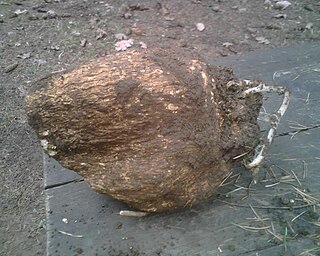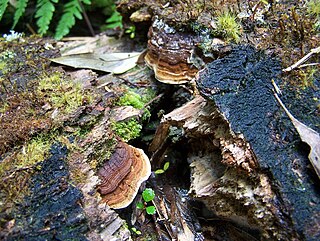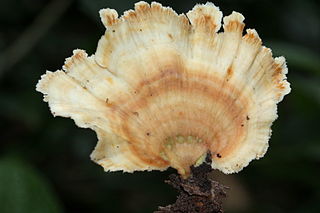Gordon Herriot Cunningham, CBE, FRS was the first New Zealand-based mycologist and plant pathologist. In 1936 he was appointed the first director of the DSIR Plant Diseases Division. Cunningham established the New Zealand Fungal Herbarium, and he published extensively on taxonomy of many fungal groups. He is regarded as the 'Father' of New Zealand mycology.

The Polyporaceae are a family of poroid fungi belonging to the Basidiomycota. The flesh of their fruit bodies varies from soft to very tough. Most members of this family have their hymenium in vertical pores on the underside of the caps, but some of them have gills or gill-like structures. Many species are brackets, but others have a definite stipe – for example, Polyporus badius.

Oxyporus is a genus of polypore fungi in the family Schizoporaceae. An individual family Oxyporaceae was described for the genus. A number of species in this genus are plant pathogens, causing a white rot. The genus is widely distributed.

Rigidoporus is a genus of fungi in the family Meripilaceae. Many of the species in this genus are plant pathogens. The widespread genus, which contains about forty species, was originally circumscribed by American mycologist William Alphonso Murrill in 1905. The generic name combines the Latin word rigidus ("rigid") with the Ancient Greek word πόρος ("pore").

Antrodiella citrea is a bracket fungus native to Australia, and New Zealand.

Postia is a genus of brown rot fungi in the family Fomitopsidaceae.

Wolfiporia is a genus of fungi in the family Polyporaceae. The genus was circumscribed by Leif Ryvarden and Robert Lee Gilbertson in 1984 to contain the type species Wolfiporia cocos and W. dilatohypha. The genus is named in honor of mycologist Frederick Adolph Wolf, who was the first to officially describe the type species.

Ischnoderma is a genus of polypore fungi. Species in the genus have dark brown and tomentose fruit bodies that become darker brown to black and smooth when mature. The genus, widespread in temperate regions, contains an estimated 10 species.

Australoporus is a genus of fungi in the family Polyporaceae. It is a monotypic genus, containing the single species Australoporus tasmanicus, found in Tasmania. The genus was circumscribed in 1988 by mycologists Peter Buchanan and Leif Ryvarden to contain the species then known as Polyporus tasmanicus.
Austrolentinus is a fungal genus in the family Polyporaceae. Segregated from the genus Lentinus, it is monotypic, containing the single species Austrolentinus tenebrosus, which was first described by E.J.H. Corner in 1981 as Panus tenebrosus. Austrolentinus was circumscribed by Norwegian mycologist Leif Ryvarden in 1991. The fungus occurs in Queensland, Solomon Islands and Papua New Guinea, and the Malay Peninsula.

Flabellophora is a genus of poroid fungi in the family Steccherinaceae. The genus was circumscribed by New Zealand-based mycologist Gordon Herriot Cunningham 1965. Most species in the genus were described by E. J. H. Corner in 1987.

Skeletocutis is a genus of about 40 species of poroid fungi in the family Polyporaceae. The genus has a cosmopolitan distribution, although most species are found in the Northern Hemisphere. It causes a white rot in a diverse array of woody substrates, and the fruit bodies grow as a crust on the surface of the decaying wood. Sometimes the edges of the crust are turned outward to form rudimentary bracket-like caps.

Tyromyces is a genus of poroid fungi in the family Polyporaceae. It was circumscribed by mycologist Petter Karsten in 1881. The type species is the widely distributed Tyromyces chioneus, commonly known as the white cheese polypore. The phylogenetic position of Tyromyces within the Polyporales is uncertain, but it appears that it does not belong to the "core polyporoid clade". Tyromyces is polyphyletic as it is currently circumscribed, and has been described as "a dumping place for monomitic white-rot species with thin-walled spores."

Fomes hemitephrus is a bracket fungus in the family Polyporaceae. First named Polyporus hemitephrus by English naturalist Miles Joseph Berkeley in 1855, it was given its current name by the English mycologist Mordecai Cubitt Cooke in 1885. The species is found in Australia and New Zealand, and is one of the most common polypores in those countries, causing a white rot on several tree species.

Inonotus nothofagi is a species of fungus in the family Hymenochaetaceae. It is parasitic, and causes a white rot in the wood it infects. First described scientifically by mycologist George Herriot Cunningham, it is found in Australia and New Zealand where it infects Nothofagus cunninghamii, and India, where it grows on oak.

Laetiporus portentosus is a species of polypore fungus in the family Fomitopsidaceae. It is found in South America, Australia, and New Zealand. It has been used traditionally as a tinder and to carry fire by Australian Aboriginals, and by New Zealand Māori people. The Māori have also used it as a "wound protector, to soften and ease a difficult labor."

Metuloidea is a genus of five species of fungi in the family Steccherinaceae. The genus was circumscribed by New Zealand-based mycologist Gordon Herriot Cunningham in 1965. The type species is M. tawa, a fungus originally described by Cunningham as a species of Trametes. Formerly classified in family Meruliaceae, Metuloidea was moved to the Steccherinaceae in 2016, following prior research that outlined a revised framework for the Steccherinaceae based on molecular phylogenetics.

Tyromyces pulcherrimus, commonly known as the strawberry bracket, is a species of poroid fungus in the family Polyporaceae. It is readily recognisable by its reddish fruit bodies with pores on the cap underside. The fungus is found natively in Australia and New Zealand, where it causes a white rot in living and dead logs of southern beech and eucalyptus. In southern Brazil, it is an introduced species that is associated with imported eucalypts.
Skeletocutis stramentica is a species of poroid fungus in the family Polyporaceae that is found in New Zealand.
Tyromyces toatoa is a species of poroid fungus found in New Zealand. It was described as a new species by G. H. Cunningham in 1965. The type collections were made by Joan Dingley, who found the fungus in Taupō, Mount Ruapehu, near Whakapapa Stream. She found it fruiting on the bark of dead branches and trunks of Phyllocladus alpinus, at an elevation of 1,000 metres (3,300 ft). The specific epithet toatoa evokes the Māori name of the host plant.
















